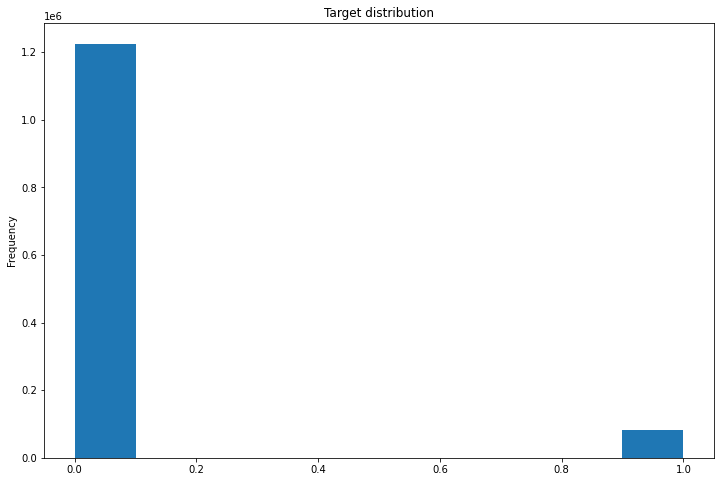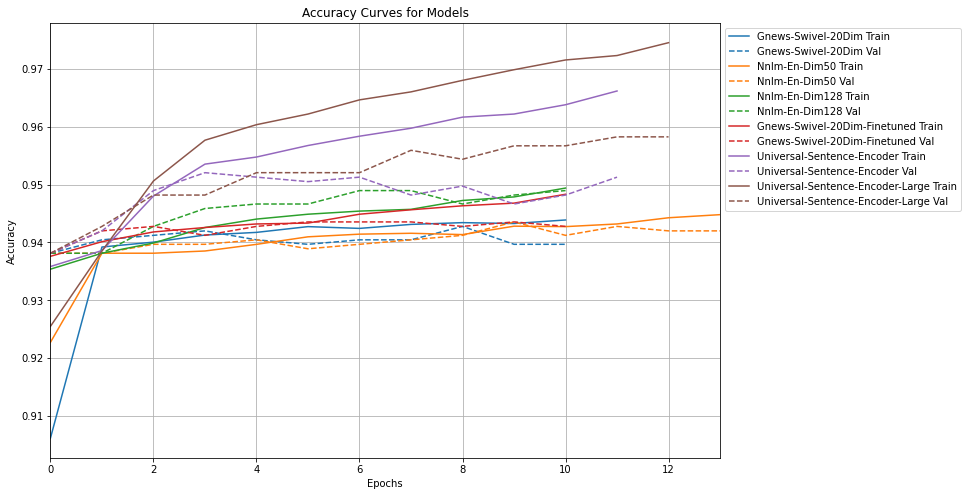Coursera
Transfer Learning for NLP with TensorFlow Hub
This is a starter notebook for the guided project Transfer Learning for NLP with TensorFlow Hub
A complete version of this notebook is available in the course resources.
Overview
TensorFlow Hub is a repository of pre-trained TensorFlow models.
In this project, you will use pre-trained models from TensorFlow Hub with tf.keras for text classification. Transfer learning makes it possible to save training resources and to achieve good model generalization even when training on a small dataset. In this project, we will demonstrate this by training with several different TF-Hub modules.
Learning Objectives
By the time you complete this project, you will be able to:
- Use various pre-trained NLP text embedding models from TensorFlow Hub
- Perform transfer learning to fine-tune models on your own text data
- Visualize model performance metrics with TensorBoard
Prerequisites
In order to be successful with this project, it is assumed you are:
- Competent in the Python programming language
- Familiar with deep learning for Natural Language Processing (NLP)
- Familiar with TensorFlow, and its Keras API
Contents
This project/notebook consists of several Tasks.
- Task 1: Introduction to the Project.
- Task 2: Setup your TensorFlow and Colab Runtime
- Task 3: Download and Import the Quora Insincere Questions Dataset
- Task 4: TensorFlow Hub for Natural Language Processing
- Task 5: Define Function to Build and Compile Models
- Task 6: Define Function to Build and Compile Models(Continued…)
- Task 7: Train Various Text Classification Models
- Task 8: Compare Accuracy and Loss Curves
- Task 9: Fine-tuning Models from TF Hub
- Task 10: Train Bigger Models and Visualize Metrics with TensorBoard
Task 2: Setup your TensorFlow and Colab Runtime.
You will only be able to use the Colab Notebook after you save it to your Google Drive folder. Click on the File menu and select “Save a copy in Drive…
Check GPU Availability
Check if your Colab notebook is configured to use Graphical Processing Units (GPUs). If zero GPUs are available, check if the Colab notebook is configured to use GPUs (Menu > Runtime > Change Runtime Type).
!nvidia-smi
Sun Jul 3 01:41:59 2022
+-----------------------------------------------------------------------------+
| NVIDIA-SMI 460.32.03 Driver Version: 460.32.03 CUDA Version: 11.2 |
|-------------------------------+----------------------+----------------------+
| GPU Name Persistence-M| Bus-Id Disp.A | Volatile Uncorr. ECC |
| Fan Temp Perf Pwr:Usage/Cap| Memory-Usage | GPU-Util Compute M. |
| | | MIG M. |
|===============================+======================+======================|
| 0 Tesla T4 Off | 00000000:00:04.0 Off | 0 |
| N/A 35C P8 9W / 70W | 0MiB / 15109MiB | 0% Default |
| | | N/A |
+-------------------------------+----------------------+----------------------+
+-----------------------------------------------------------------------------+
| Processes: |
| GPU GI CI PID Type Process name GPU Memory |
| ID ID Usage |
|=============================================================================|
| No running processes found |
+-----------------------------------------------------------------------------+
import numpy as np
import pandas as pd
import tensorflow as tf
import tensorflow_hub as hub
import tensorflow_datasets as tfds
import matplotlib.pyplot as plt
plt.rcParams['figure.figsize'] = (12, 8)
from IPython import display
import pathlib
import shutil
import tempfile
!pip install -q git+https://github.com/tensorflow/docs
import tensorflow_docs as tfdocs
import tensorflow_docs.modeling
import tensorflow_docs.plots
print("Version: ", tf.__version__)
print("Hub version: ", hub.__version__)
print("GPU is", "available" if tf.config.list_physical_devices('GPU') else "NOT AVAILABLE")
logdir = pathlib.Path(tempfile.mkdtemp())/"tensorboard_logs"
shutil.rmtree(logdir, ignore_errors=True)
Building wheel for tensorflow-docs (setup.py) ... [?25l[?25hdone
Version: 2.8.2
Hub version: 0.12.0
GPU is available
Task 3: Download and Import the Quora Insincere Questions Dataset
A downloadable copy of the Quora Insincere Questions Classification data can be found https://archive.org/download/fine-tune-bert-tensorflow-train.csv/train.csv.zip. Decompress and read the data into a pandas DataFrame.
df = pd.read_csv('https://archive.org/download/fine-tune-bert-tensorflow-train.csv/train.csv.zip',
compression = 'zip', low_memory = False)
df.shape
(1306122, 3)
df['target'].plot(kind = 'hist', title = 'Target distribution')
<matplotlib.axes._subplots.AxesSubplot at 0x7f3dfb769550>

from sklearn.model_selection import train_test_split
train_df, remaining = train_test_split(
df, random_state = 42, train_size = .01, stratify = df.target.values
)
valid_df, _ = train_test_split(
remaining, random_state = 42, train_size = .001, stratify = remaining.target.values
)
train_df.shape, valid_df.shape
((13061, 3), (1293, 3))
train_df.target.head(15).values
array([0, 0, 0, 0, 0, 0, 0, 0, 0, 0, 0, 1, 0, 0, 0])
train_df.question_text.head(15).values
array(['What is your experience living in Venezuela in the current crisis? (2018)',
'In which state/city the price of property is highest?',
'Do rich blacks also call poor whites, “White Trash”?',
'Should my 5 yr old son and 2 yr old daughter spend the summer with their father, after a domestic violent relationship?',
'Why do we have parents?',
'Do we experience ghost like Murphy did in Interstellar?',
'Are Estoniano women beautiful?',
'There was a Funny or Die video called Sensitivity Hoedown that got pulled. Does anyone know why?',
'Is it a good idea to go in fully mainstream classes, even if I have meltdowns that might disrupt people?',
'What classifies a third world country as such?',
'Is being a pilot safe?',
'Who is Illiteratendra Modi? Why does he keep with him a Rs 1 lakh pen?',
'Have modern management strategies such as Total supply Chain Management applied to education? Can they be?',
'Why are Lucky Charms considered good for you?',
'How many people in India use WhatsApp, Facebook, Twitter and Instagram?'],
dtype=object)
Task 4: TensorFlow Hub for Natural Language Processing
Our text data consits of questions and corresponding labels.
You can think of a question vector as a distributed representation of a question, and is computed for every question in the training set. The question vector along with the output label is then used to train the statistical classification model.
The intuition is that the question vector captures the semantics of the question and, as a result, can be effectively used for classification.
To obtain question vectors, we have two alternatives that have been used for several text classification problems in NLP:
- word-based representations and
- context-based representations
Word-based Representations
- A word-based representation of a question combines word embeddings of the content words in the question. We can use the average of the word embeddings of content words in the question. Average of word embeddings have been used for different NLP tasks.
- Examples of pre-trained embeddings include:
- Word2Vec: These are pre-trained embeddings of words learned from a large text corpora. Word2Vec has been pre-trained on a corpus of news articles with 300 million tokens, resulting in 300-dimensional vectors.
- GloVe: has been pre-trained on a corpus of tweets with 27 billion tokens, resulting in 200-dimensional vectors.
Context-based Representations
- Context-based representations may use language models to generate vectors of sentences. So, instead of learning vectors for individual words in the sentence, they compute a vector for sentences on the whole, by taking into account the order of words and the set of co-occurring words.
- Examples of deep contextualised vectors include:
- Embeddings from Language Models (ELMo): uses character-based word representations and bidirectional LSTMs. The pre-trained model computes a contextualised vector of 1024 dimensions. ELMo is available on Tensorflow Hub.
- Universal Sentence Encoder (USE): The encoder uses a Transformer architecture that uses attention mechanism to incorporate information about the order and the collection of words. The pre-trained model of USE that returns a vector of 512 dimensions is also available on Tensorflow Hub.
- Neural-Net Language Model (NNLM): The model simultaneously learns representations of words and probability functions for word sequences, allowing it to capture semantics of a sentence. We will use a pretrained models available on Tensorflow Hub, that are trained on the English Google News 200B corpus, and computes a vector of 128 dimensions for the larger model and 50 dimensions for the smaller model.
Tensorflow Hub provides a number of modules to convert sentences into embeddings such as Universal sentence ecoders, NNLM, BERT and Wikiwords.
Transfer learning makes it possible to save training resources and to achieve good model generalization even when training on a small dataset. In this project, we will demonstrate this by training with several different TF-Hub modules.
module_url = "https://tfhub.dev/google/tf2-preview/gnews-swivel-20dim/1" #@param ["https://tfhub.dev/google/tf2-preview/gnews-swivel-20dim/1", "https://tfhub.dev/google/tf2-preview/nnlm-en-dim50/1", "https://tfhub.dev/google/tf2-preview/nnlm-en-dim128/1", "https://tfhub.dev/google/universal-sentence-encoder/4", "https://tfhub.dev/google/universal-sentence-encoder-large/5"] {allow-input: true}
Tasks 5 & 6: Define Function to Build and Compile Models
def train_and_evaluate_model(module_url, embed_size, name, trainable=False):
hub_layer = hub.KerasLayer(
module_url, input_shape = [], output_shape = [embed_size],
dtype = tf.string, trainable = trainable
)
model = tf.keras.models.Sequential([
hub_layer,
tf.keras.layers.Dense(256, activation = 'relu'),
tf.keras.layers.Dense(64, activation = 'relu'),
tf.keras.layers.Dense(1, activation = 'sigmoid'),
])
model.compile(
optimizer = tf.keras.optimizers.Adam(learning_rate = .0001),
loss = tf.losses.BinaryCrossentropy(),
metrics = [tf.metrics.BinaryAccuracy(name = 'accuracy')]
)
model.summary()
history = model.fit(
train_df['question_text'], train_df['target'],
epochs = 100, batch_size = 32,
validation_data = (valid_df['question_text'], valid_df['target']),
callbacks = [
tfdocs.modeling.EpochDots(),
tf.keras.callbacks.EarlyStopping(
monitor = 'val_loss', patience = 2, mode = 'min'
),
tf.keras.callbacks.TensorBoard(logdir/name)
],
verbose = 0
)
return history
Task 7: Train Various Text Classification Models
histories = {}
module_url = "https://tfhub.dev/google/universal-sentence-encoder-large/5" #@param ["https://tfhub.dev/google/tf2-preview/gnews-swivel-20dim/1", "https://tfhub.dev/google/tf2-preview/nnlm-en-dim50/1", "https://tfhub.dev/google/tf2-preview/nnlm-en-dim128/1", "https://tfhub.dev/google/universal-sentence-encoder/4", "https://tfhub.dev/google/universal-sentence-encoder-large/5"] {allow-input: true}
model_name = 'universal-sentence-encoder-large'
model_dim = 512
trainable = False
histories[model_name] = train_and_evaluate_model(
module_url, embed_size = model_dim, name = model_name, trainable = trainable
)
Model: "sequential_10"
_________________________________________________________________
Layer (type) Output Shape Param #
=================================================================
keras_layer_11 (KerasLayer) (None, 512) 147354880
dense_30 (Dense) (None, 256) 131328
dense_31 (Dense) (None, 64) 16448
dense_32 (Dense) (None, 1) 65
=================================================================
Total params: 147,502,721
Trainable params: 147,841
Non-trainable params: 147,354,880
_________________________________________________________________
Epoch: 0, accuracy:0.9255, loss:0.3213, val_accuracy:0.9381, val_loss:0.1760,
.............
Task 8: Compare Accuracy and Loss Curves
plt.rcParams['figure.figsize'] = (12, 8)
plotter = tfdocs.plots.HistoryPlotter(metric = 'accuracy')
plotter.plot(histories)
plt.xlabel("Epochs")
plt.legend(bbox_to_anchor=(1.0, 1.0), loc='upper left')
plt.title("Accuracy Curves for Models")
plt.show()

plotter = tfdocs.plots.HistoryPlotter(metric = 'loss')
plotter.plot(histories)
plt.xlabel("Epochs")
plt.legend(bbox_to_anchor=(1.0, 1.0), loc='upper left')
plt.title("Loss Curves for Models")
plt.show()

Task 9: Fine-tune Model from TF Hub
Task 10: Train Bigger Models and Visualize Metrics with TensorBoard
%load_ext tensorboard
%tensorboard --logdir {logdir}
Output hidden; open in https://colab.research.google.com to view.